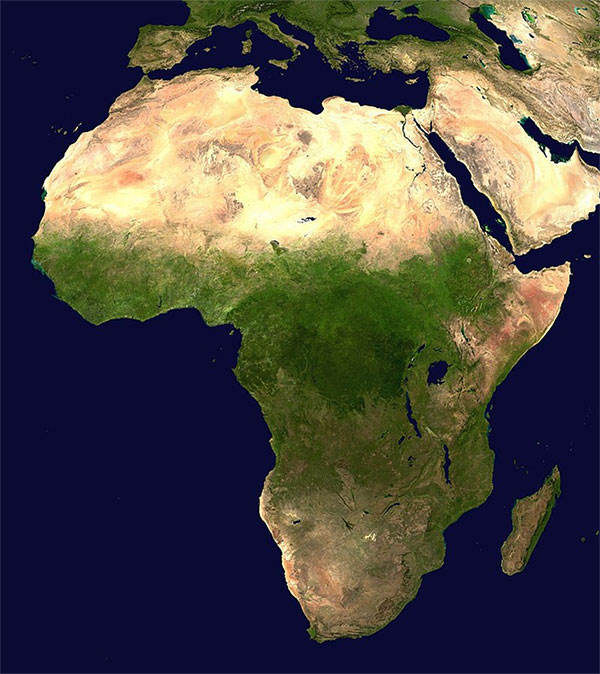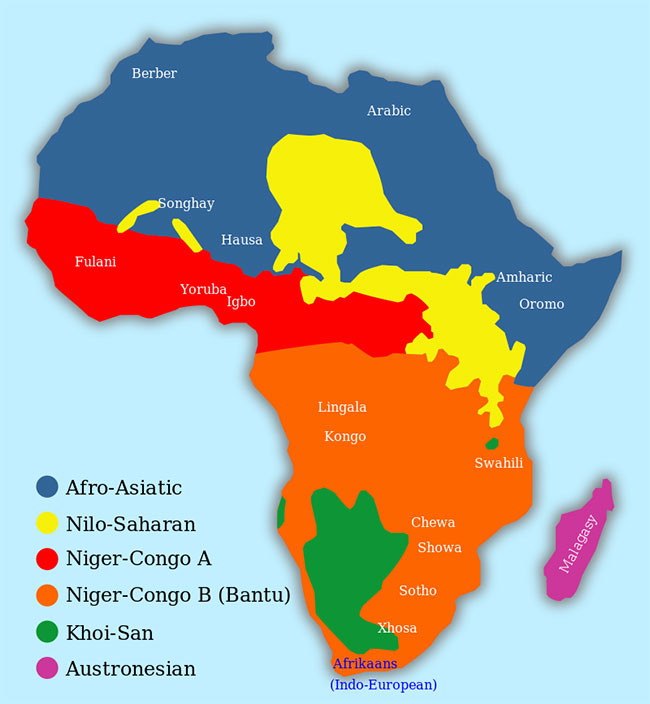Learn about Africa
Africa (or Africa) is the second largest continent in the world in terms of population (after Asia), and the third in area (after Asia and the Americas).
Things to know about Africa
With an area of about 29,661,703 km² (11,452,448 mi²) (not including adjacent islands) it occupies 19% of the Earth's land. With 1,384,087,771 people living in 54 countries as of 2021, Africa accounts for about 17.52% of the world's population.
Location of Africa
Africa is the largest of the three water bodies south of the Earth's surface. It covers an area of approximately 30,221,532 km² (11,668,599 mi²) including the islands. Most of the area is located between Tropic of Cancer and Tropic of Cancer, so the climate is hot all year round.
Separated by the Mediterranean Sea from Europe, it is connected to Asia to the northeast by the Isthmus of Suez (crossed by the Suez Canal) 130 km (80 mi) wide.

Satellite image of Africa.
Geographically, Egypt's Sinai Peninsula lies east of the Suez Canal (also commonly referred to as Africa). From the furthest northward point is Ras ben Sakka in Tunisia, west of Cape Blanc, at 37°21' north latitude, to the southernmost point is Cape Agulhas in South Africa, 34°51′15″ south, about 8,000 kilometers (5,000 miles) apart; from Cape Verde, 17°33′22″ west, which is the furthest west to Ras Hafun in Somalia, 51°27′52″ east, a distance of approximately 7,400km (4,600 miles).
The length of the coast is 26,000km (16,100 miles). The absence of deep depressions along the coastline is compared realistically to the size of Europe, which has an area of only 9,700,000 km² (3,760,000 ml2) but has a coastline of 32,000 km (19,800 km). mile).
The main structural lines of the continent are shown in both a west-east direction (at least in the northern hemisphere) of the more northerly parts and a north-south direction in the southern peninsulas. Africa can therefore be considered as a combination of two perpendicular parts, the northern part running from east to west, the southern part running north-south.
Terrain in Africa
The topography of Africa is quite simple. The entire continent can be considered as a giant plateau, with an average height of 750m; on it are mainly plains interspersed with lowland basins. The eastern part of the continent was strongly uplifted, the bedrock cracked and collapsed, forming many deep valleys, many narrow and long lakes. Africa has very few high mountains and low plains.
Climate in Africa
Africa's climate is a wide range of climates: equatorial, tropical wet, tropical monsoon, semi-arid (semi-desert and savanna), desert (super-arid) and arid), and highland subtropical climate.
Temperate climates are rare throughout the continent except at very high altitudes and along marginal regions. In fact, Africa's climate is changed more by rainfall than by temperature, which is always high. The African deserts are the sunniest and driest places on the continent, due to the widespread presence of subtropical ridges with hot, dry, subsidence air masses.
Africa holds many heat-related records: the continent has the hottest extension all year round, the regions with the hottest summer climates, the highest sunny periods, etc.
Because of Africa's location on equatorial and subtropical latitudes in both the northern and southern hemispheres, several different climate patterns can be found within it. This continent is mainly located in the intertropical zone between the Tropic of Cancer and the Tropic of Cancer, so it has an interesting moisture density. The intensity of precipitation is always high and the continent is hot. Warm and hot climates are common throughout Africa, but much of the northern part is marked by aridity and high temperatures. Only the northernmost and southernmost edges of the continent have a Mediterranean climate. The equator runs through the middle of Africa, as well as the Tropic of Cancer and Tropic of Cancer, making Africa the most tropical continent.
The already hot, dry climate that stretches across the equator makes it the most vulnerable continent to climate change.
African economy
Africa is the world's poorest inhabited continent, and this poverty is on average up from 25 years ago.
In Africa, which has been in an unstable transition from colonialism to the new post-Cold War era, the rise of corruption and autocracy are the main factors. to explain the weak economy. The rapid growth of China and now India, or the moderate growth of South American countries that have raised the living standards of millions of people, Africa has stalled, even lagged behind in trade. trade, investment and per capita income. This poverty has wide-ranging effects, including low life expectancy, violence and instability – factors that are intertwined and linked to the poverty of the continent. Over the decades a variety of solutions have been proposed and many of them have been implemented, but none have achieved significant success.
Part of the problem is that foreign aid is generally used to encourage the cultivation of cash crops such as cotton, cocoa and coffee in areas of subsistence agriculture. However, at the same time, industrialized countries pursued policies to lower the prices of products from these crops. For example, the true cost of cotton grown in West Africa is about half the cost of cotton grown in the United States thanks to cheap labor. However, American cotton is sold at a lower price than African cotton because cotton growing in the US is heavily subsidized. As a result, the prices of these items today are only approximately those of the 1960s.
Africa also suffers from constant capital outflows. In general, the income that comes to African countries goes away quickly, either because the assets sold are owned by foreigners (oil is a prime example) and the proceeds are remitted. to foreign owners, or the funds must be used to repay loans from industrialized countries or the World Bank. It is estimated that Africa could reduce its dependence on foreign aid significantly if all profits made in African countries were reinvested in the region for at least 12 months.
Africa's population
African populations can be conveniently grouped by the region in which they live north or south of the Sahara; these groups are called North Africans and Sub-Saharan Africans respectively.
Arabic-speaking Arab-Berbers dominate North Africa, while sub-Saharan Africa is dominated by a large disparate population, generally grouped together as 'blacks' due to their dark complexion.
There is a diversity of body types here among sub-Saharan Africans - ranging from the Masai and Tutsi, known for their tall stature, to the Pygmies, who were of great stature. smallest body in the world.
Languages in Africa

Map showing the distribution of linguistic families and some major languages in Africa. The Afro-Asian system extends to the Sahel and Southwest Asia. The Niger-Congo family is subdivided to indicate the size of the Bantu language family.
By most estimates, Africa has over a thousand languages. There are four major language families native to Africa.
- The Afro-Asiatic language family is a family of some 240 languages and 285 million speakers spread across North Africa, East Africa, the Sahel and Southwest Asia.
- The Nin-Saharan language family includes more than 100 languages spoken by about 30 million people. Nil-Saharan languages are mainly spoken in Chad, Sudan, Ethiopia, Uganda, Kenya and northern Tanzania.
- The Niger-Congo language family covers much of sub-Saharan Africa and is perhaps the largest language family in the world when it comes to having a variety of languages. One notable among them is that the Bantu languages are most widely spoken in sub-Saharan Africa.
- The Khoisan language family number more than 50 languages and are spoken by about 120,000 people in southern Africa. Many of the languages in this family are in a state of extinction. The Khoi and San are considered to be the original inhabitants of this region.
- European languages also had some significant influence; English, French, Portuguese and Spanish are official languages in some countries as a result of colonization. In the Republic of South Africa, where a significant number of people of European descent live, English and Afrikaan are the native languages of a significant portion of the population.
African culture
Instead of having one culture, Africa has a large number of cultures that are intermingled with each other. The most common distinction is between sub-Saharan Africa and the rest of the countries north from Egypt to Morocco, which often associate themselves with Arab culture. In this comparison, countries south of the Sahara are considered to be multicultural, namely those within the Bantu language group.
Division could also be accomplished by dividing French-speaking Africa from the rest of Africa, namely the former British colonies of southern and eastern Africa. Another flawed division is the division between traditional Africans and fully modernists. The "traditional people" are sometimes divided into cattle breeders and farmers.
African art reflects the diversity of African cultures. The oldest surviving art in Africa are other 6,000-year-old carvings found in Niger, while the Great Pyramids of Giza in Egypt were the tallest architectural complex in the world for some 4,000 years up to when the Eiffel Tower was built. The complex of stone churches in Lalibela, Ethiopia, of which the Church of St. George is representative, considered another feat of the construction industry.
Religion in Africa
Africans follow many types of religion, with Christianity and Islam being the most popular. About 40% of Africa's population is Christian and 40% Muslim. The remaining 20% follow mainly indigenous African religions. A small number of Africans also adhere to Jewish beliefs, such as the Beta Israel and Lemba tribes.
Indigenous African religions tend to evolve around animism and ancestor worship. The general idea of traditional belief systems is to divide the spiritual world into "helpful" and "harmful".
The world of beneficial spirits is generally believed to include ancestral spirits helping their descendants or spirits with the power to protect entire communities from natural disasters or attacks by humans. enemy; while the harmful spirit world includes the souls of murder victims who are buried without proper burial rites and the kinds of demons that mediums and grandmothers use. used to create disease for their enemies.
While the impact of these primitive forms of worship is still ongoing and profoundly influential, those belief systems also evolved through contact with other religions.
- 8 false rumors that everyone believes in Africa
- Magical Africa through photo beams
- Why don't you learn how to swim forever?
- 8 maps blow your thoughts about the black continent
- Strange and interesting things make visitors surprised about Africa
- Africa is strong enough to
- Africa's most bizarre fox: Cute to beat but even hunted newspapers
- East Africa: The desert is at risk of turning into a sea
- Chimpanzees can learn and transmit new habits
- Pull the ice from the North Pole to Africa
- Study birds to discover how children learn to speak
- South Africa established a climate change center
 The 11 most unique public toilets in the world
The 11 most unique public toilets in the world Explore the ghost town in Namibia
Explore the ghost town in Namibia Rare historical moments are 'colored', giving us a clearer view of the past
Rare historical moments are 'colored', giving us a clearer view of the past The world famous ghost ship
The world famous ghost ship